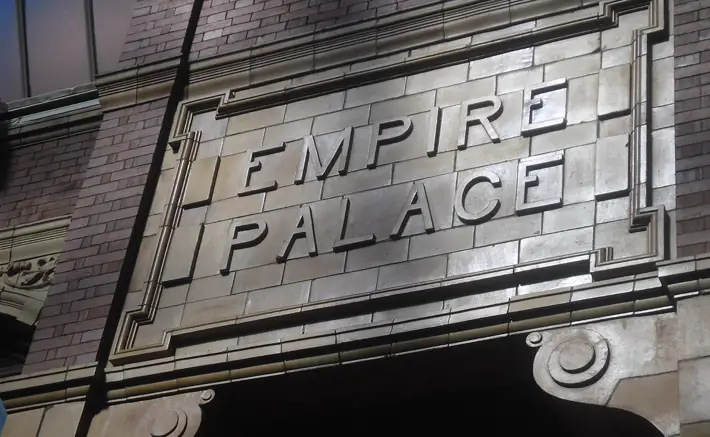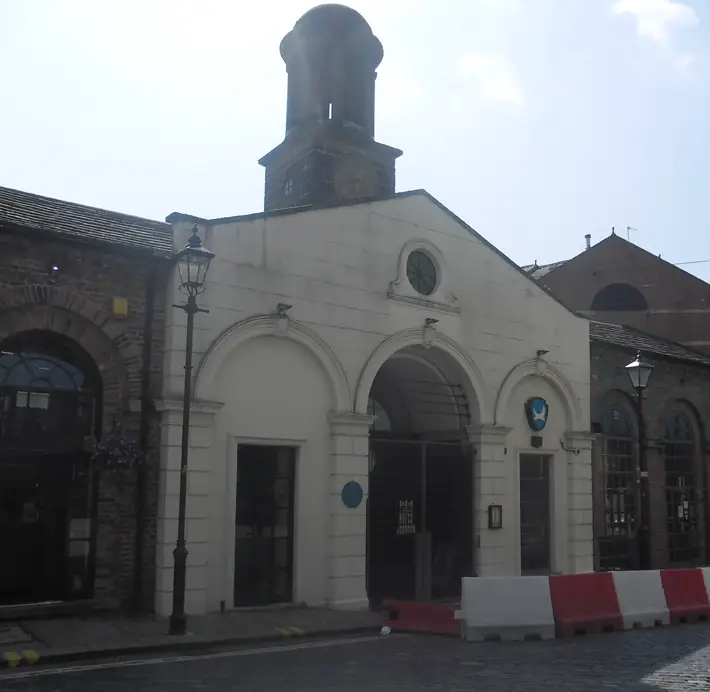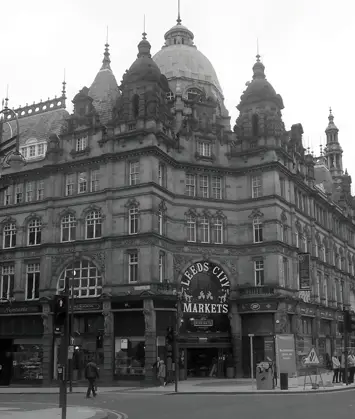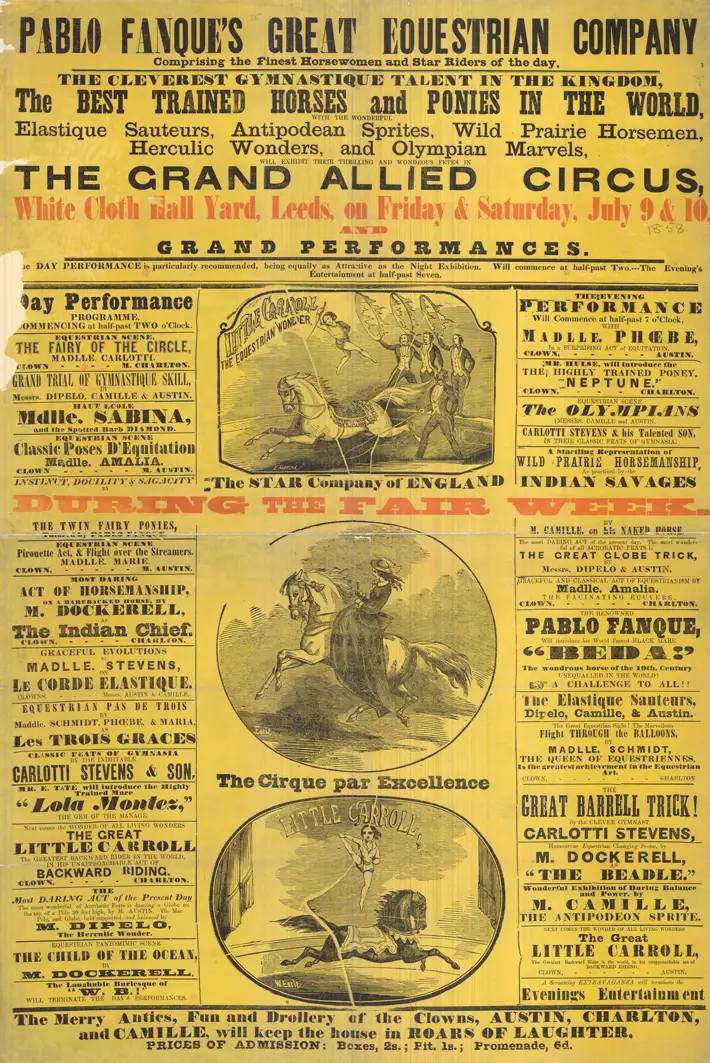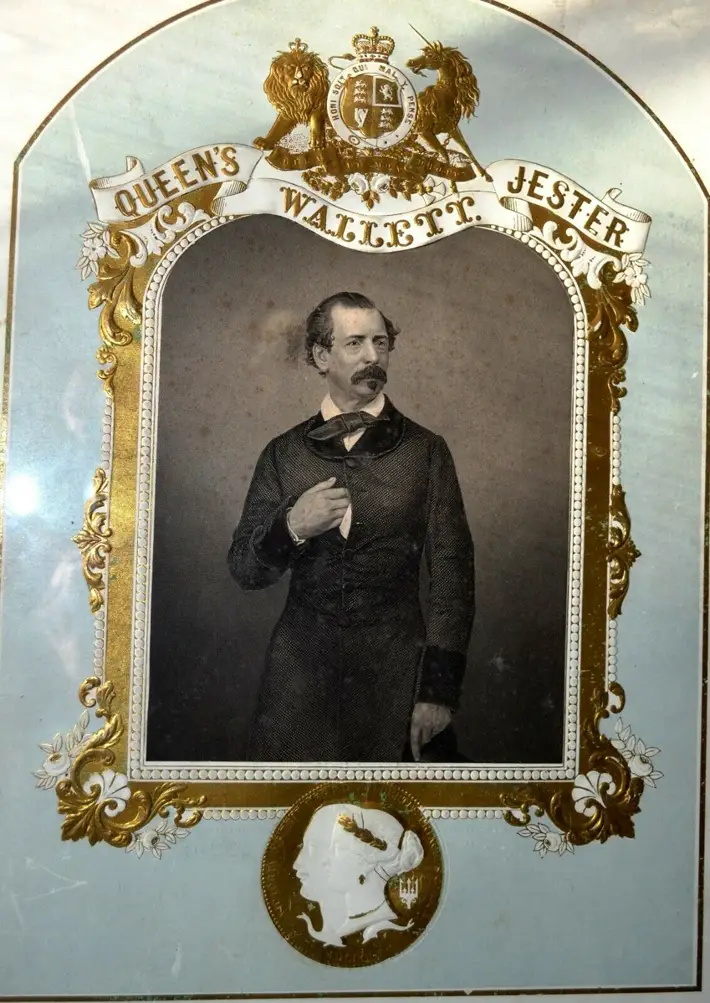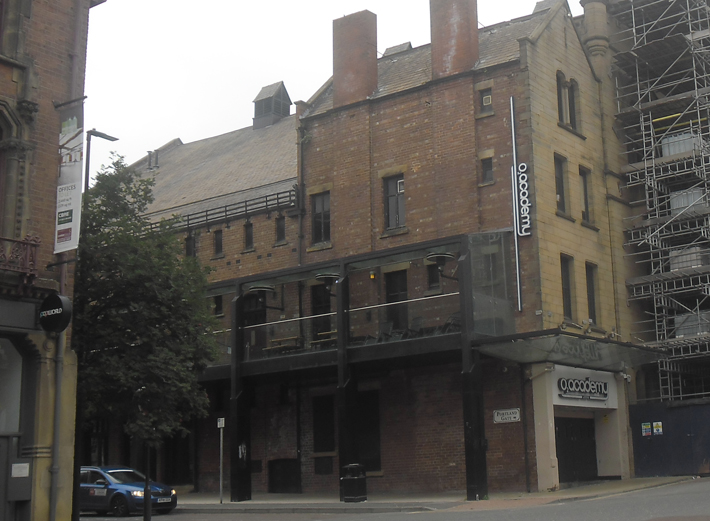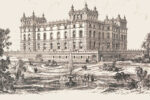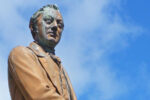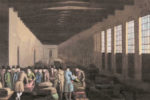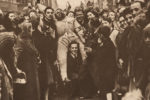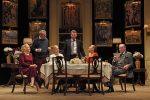A Stroll Through the The Victorian Circuses of Leeds
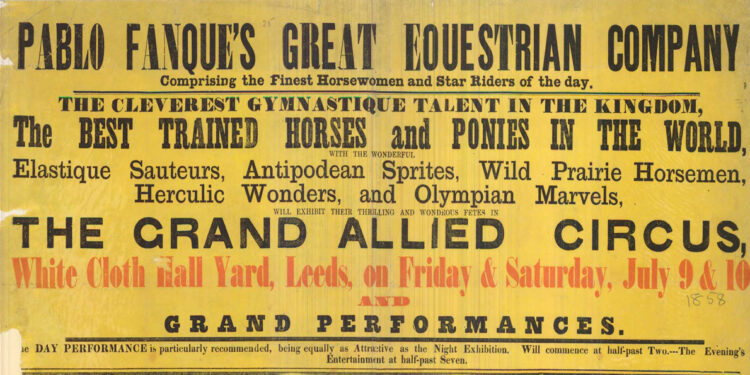
By Dr. Steve Ward
The Victorian era was the golden age of the circus. By the time that Victoria came to the throne the circus, as we might recognise it today, was barely seventy years old. Founded in London by Philip Astley in 1768 with displays of horsemanship, military, and trick riding the circus had expanded rapidly in the following years. Astley travelled throughout England giving performances in many northern towns and cities until he eventually made his way to Dublin. Performances were either given in the open air or in hastily constructed wooden ‘amphitheatres’; wood was plentiful and labour was cheap. In modern parlance one might almost describe them as ‘pop-up’ circus venues.
In Britain the circus was particularly popular in the northern central corridor, from Liverpool in the west to Hull in the east, and took in many industrial and commercial centres such as Manchester, Preston, Burnley, Huddersfield, Leeds, and York to name but a few. That is not to say the circus did not visit other places within Britain, it did and was very popular, but the ‘north’ provided rich pickings for many circus companies. There was a demand for cheap entertainment and the circus provided an escape from the everyday drudgery of life for many.
In Leeds alone there were at least twelve venues within the centre that were used for visiting circuses during this period. There were also several others just outside of the centre. To date, I have been able to identify a total of sixteen different venues in use during the Victorian era, more I believe than any other town or city within the UK, except for perhaps London. Some of these venues were in semi-permanent buildings largely constructed of timber and were used by different companies over an extended period of time. Some were in purpose built brick buildings, and other venues were on open lots of land where a marquee would be erected for the duration of the visit.
I would like to take you on a guided journey around these sites. For those who know Leeds the street names will be familiar and the guide easy to follow. But I hope that there will be some of you from outside of Leeds who might want to explore the rich cultural history of the Victorian circus in the city.
“Princely sum”
Let us begin our journey outside of the Grand Theatre on New Briggate. This imposing building was opened in 1878. Before this the land was owned by the Leeds Tramway Company and on this site Charles Adams ran his Grand Circus between 1875 and 1876, after which time the land was sold for the construction of the theatre. A visit to Adam’s Grand Circus could cost as little as 6d (six old pre-decimal pennies equivalent to approximately £1.75 today), or for the princely sum of 3s (three shillings equivalent to £10 today) one could sit in luxury in ‘velvet cushioned arm chairs’ or in ‘sofa lounges’. Entertainments included William Wallett the Queen’s Jester and Cee Mee the Man Fly, in his ‘Ceiling Walking Extraordinary’.
With your back to the entrance of the Grand Theatre, face left and walk along New Briggate until you get to the major junction with the Headrow. Cross the Headrow by the pedestrian lights and continue forward on Briggate until you are standing outside of the entrance to Harvey Nichols store.
Briggate is now a pedestrianised area but for many years it was the main north – south thoroughfare through Leeds. Certainly during the Victorian era it was a hive of activity. If you cross the street and look back at the entrance to the Harvey Nichols store you will be looking at where the entrance to the Empire Palace Theatre would have been, opened in 1898. Although not strictly a circus venue per se it did support many of the circus arts and is worthy of a mention on our tour.
“Ornate building”
Enter the Victoria Quarter arcade, formerly Victoria Street until it was roofed over, next to Harvey Nichols and continue until the intersection with Cross Arcade. Here turn right and a little further along on your right, set high above the rear door of Harvey Nichols you will see the ‘Empire Palace Stone’. This door would have been the stage door to the theatre leading to the backstage areas. It is the one lasting visible remains of the once proud variety theatre where many circus performers, my own ancestor included, once performed.
Continue along Cross Arcade until you exit onto King Edward Street. Before you turn left look across at the entrance to Fish Street. This narrow street would have been typical of many smaller streets in this area during Victorian times. Walk left along King Edward Street and then cross Vicar Lane at the pedestrian lights to stand outside of the Leeds Kirkgate Market.
Like most of the other circus venues on our tour, this site has long since been redeveloped and the original Vicars Croft no longer exists. The area known as Vicars Croft, the original market ‘shambles’, is now covered by the present market buildings. One of the earliest notes of a circus on Vicars Croft was given in the Leeds Intelligencer of 8 July 1824. Cooke’s Olympic Circus presented performances in a temporary wooden structure during the Leeds Horse Fair.
With Kirkgate Market on your left we continue forwards until we see the Corn Exchange. Pass left behind this ornate building and you will find the site of third White Cloth Hall, indicated by a blue plaque. Constructed in 1775 for the trading of white (undyed) cloth, the yard became the venue for Pablo Fanque’s Great Allied Circus in the July of 1856 and 1857.
“Vacant plot”
Continue around the Corn Exchange (pop in for a look at the stunning interior) and stand with your back to the entrance. You will now be facing Duncan Street. Walk along this street and continue on to Boar Lane. Just after the Trinity Church on your right is a small entrance, Trinity Street. Just a few yards further along is Bank Street. Between these two streets and stretching back to Commercial Street was a vacant plot of land which was in continuous use as a circus venue for almost 60 years.
Amphitheatres were constructed and re-constructed by various companies and there were entrances onto all surrounding streets; Boar lane, Bank Street, Trinity Street, and Commercial Street. The earliest record is for a Mr Wild who set up his New Riding School on the site in 1805. Many well-known companies visited this site, those of Kite, Adams, Mrs Blyth, Cooke, Bannister & West, Batty, Fanque, Bell, Franconi, and Sanger. Sanger was the last recorded occupant in 1862, where he presented a varied programme including Britannia with her tame lion. Britannia was actually Sanger’s wife who had performed as a teenager in her own right as the ‘Lion Queen’, Nellie Chapman.
Continue along Boar Lane to the junction of Albion Street. Before you turn right here, further along Boar Lane to the left is the railway station. In 1882, on New Station Street, the Victoria Amphitheatre was erected for ‘Sir’ Robert Fossett’s New Grand Cirque. It could hold 2000 people and had three entrances. The circus was 48 ft. high, with a length of 152 ft. and a breadth of 56 ft. increasing to 100 ft. where the gallery was situated. The ring was the now standard 42 ft. in diameter.
“Wooden supports”
Turn right up Albion Street and then right into Commercial Street. Along here would have been an exit from the Boar Lane amphitheatre. Turn left into Lands Lane and continue until you are standing outside of the entrance to the shopping centre on your left. Beneath this site was King Charles Croft. This was another popular venue for visiting circuses. The earliest circus performance here dates back to 1773 when Philip Astley, the founder of the ‘modern’ circus gave an open air display of horsemanship in a ‘commodious croft on Lands Lane’. In 1842 Mr Cooke announced the erection of a ‘circus of magnificent scale’4 on the site.
After Cooke came the companies of Ducrow, Hengler, and Fanque. Perhaps the best known date for the amphitheatre on King Charles Croft is 1848. During an evening performance by Fanque’s company the wooden supports for the Pit seating area collapsed. Many people were injured but the only fatality of the night was Fanque’s wife, who had been in the cash office under the Pit area at the time. She was buried a few days later in the Woodhouse cemetery (St George’s Fields). Thousands lined the streets to watch the cortege pass. Although Fanque remarried, when he died in 1871 he left instructions that his body be returned to Leeds to be buried with his first wife. Their graves can still be visited today. After this accident the site was no longer used specifically for circuses but a new Princess Theatre was built on the plot. Later it became the Tivoli and then the Hippodrome.
Continue the final few yards along Lands Lane and then turn left onto the Headrow. Cross Albion Street and a little further along on the left is Butts Court and just after that Upper Basinghall Street. Between these two streets was an open space known as ‘The Butts’, possibly a former archery practice ground. On this site in 1832, Mr Ryan set up his Royal Equestrian Circus for a season.
Walk a little further on until you are at the junction with Park Row on your left. Go right across the Headrow here and before you continue up Cookridge Street look along the Headrow towards the Leeds Town Hall. Just beyond the Town Hall is Oxford Row, now the site of the Leeds Combined Court Centre. On this plot in 1854, the visiting Hernandez & Stone American Circus erected a huge marquee for their performances.
Continue up Cookridge Street, crossing Great George Street, until you reach the Leeds Museum. This was formerly the Mechanics’ Institute established in 1819. Pass the Museum and then stop and look diagonally forwards to your left. The building with the Victorian facade was the site of the original Mr Newsome’s Grand Circus which was opened in 1867. It was advertised as being ‘spacious and comfortable, and has been decorated in a tasteful and appropriate manner’. To draw in the crowds Newsome organised special ‘circus trains’ at 11pm every Tuesday and Saturday to transport circus goers home to Huddersfield and Halifax.
“Royal Olympic Circus”
Sanger’s Grand New Circus, Pablo Fanque’s Mammoth Circus, Tannaker’s Great Dragon Company and Japanese Troupe, Hengler’s Grand Cirque Varieté, and Henry & Adams Grand Circus all used this venue. In October 1876, Charles Adams bought the site from Newsome and redeveloped it, presenting his New Circus. The new building was 122 ft. long, 84 ft. wide, and could accommodate 5000 people. In 1882 it was demolished to make way for a new and prestigious Hall for the city. Completed in 1885 it was known as the Coliseum.
Retrace your steps for a few yards and turn left into Rossington Street. At the top of this is Woodhouse Lane. Cross this and turn right until the junction with Merrion Street on your left. Bannister and West’s Circus performed here as early as 1811 but in 1849, William Wallett, the King of Jesters, set up his Royal Olympic Circus. The entrance was on Merrion Street, next to the Barracks. During his stay there Wallett also presented the solo Pablo Fanque with his famous trained mare Beda.
Continue along Merrion Street and take the first left turning onto Wade Lane that soon becomes Lovell Park Road. You will pass several large buildings on your right. After you pass an open grass area on your right with some bungalows, turn right onto Grafton Street. As you continue down Grafton Street the open area to your right is now known as North Street Recreation Ground or Lovell Park. During the latter part of the nineteenth century this was the site of the Smithfield Market or Cattle Market and housed several visiting circuses and menageries.
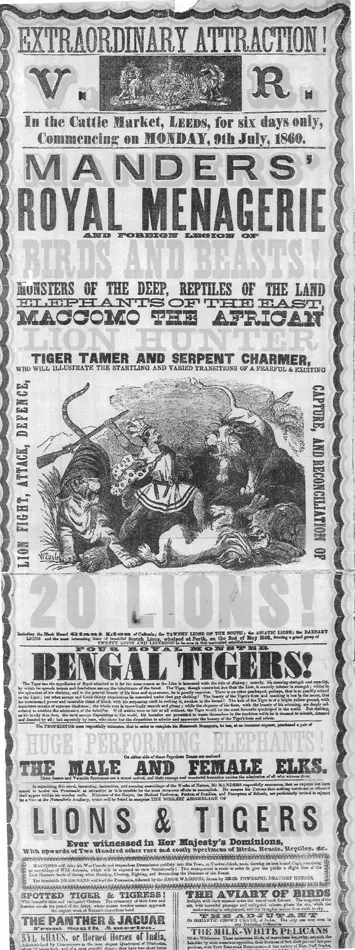
1860 poster for Manders’ Menagerie featuring Maccomo the African Lion Hunter, courtesy of Leeds Libraries
“Bare-knuckle fighter”
In 1858 the giant Howe & Cushing’s American Circus performed there ‘in a commodious building’. They visited this site for several years. Sanger’s and Cooke’s circuses also used this site through to 1866. The cattle market was also a popular venue for travelling menageries, such as Manders’ Royal Menagerie that visited in 1860. With this company was the famous black lion tamer named Maccomo.
Further afield of the city centre, to the west of the city centre along Kirkstall Road is a leisure complex known as Cardigan Fields. On this site, in 1891 and again in 1903, Buffalo Bill’s Wild West show appeared. Local people were amazed to see a small herd of bison grazing along the banks of the river Aire. The footbridge across the river from Cardigan Fields to the Armley Mills complex is known to this day as ‘Buffalo Bill Bridge’. Earlier in the 1860s, Tom Sayer’s Circus visited the site. Tom Sayer was a famous Victorian bare-knuckle fighter. When he retired from fighting he invested his money into a small circus and for a short time he also worked as a clown. Unfortunately the venture lasted little more than a year and he died shortly afterwards in 1865
North-west of the centre, between Burley and Headingley, was the Leeds Zoological and Botanical Gardens. Failing to make money, the site was bought in 1858 by a young entrepreneur named Thomas Clapham. He changed the name to the Royal Gardens and placed emphasis upon popular entertainment and fun. During this period both Cooke’s and Fanque’s circuses appeared here.
Further north from the old Smithfield Market site on Lovell Park Road, the now named Oatlands Road was once called Camp Road. Along here there was a large military camp and the associated drill ground was used as a site for travelling circuses and menageries in the last two decades of the nineteenth century. At a time when city centre space was becoming rapidly redeveloped the larger circus outfits struggled to find space and were so forced to look outwards from the city centre for suitable venues.
The earliest mention of a circus on this site was in September 1861, when Cooke’s Great Circus and Strasbourg’s Mammoth Menagerie set up for one day only with their World’s Fair on Wheels. Pavilions were erected and there were four exhibitions; a circus, an aviary, an aquarium, and a menagerie. The star attraction in the circus was Herr Holtum, who performed his most wonderful feat of catching a cannon ball as it was fired from the mouth of a cannon.
Circuses continued to perform on the drill ground on Camp Road well into the twentieth century. The very long Camp Road became Lovell Park Road and Oatlands Road during the Leeds redevelopment scheme during the 1960s.
“A culture we should celebrate”
Towards the end of the nineteenth century the popularity of circus was waning due in part to the rise of the Music Hall and the Cinematograph. As the city centre developed commercially, vacant ground was no longer available for circuses and Woodhouse Moor became a favoured location, although it had been used as early as 1846 when Pablo Fanque performed there. In the post WWII second golden age of circus, the industry was dominated by the ‘Big Three’; Mills’, Chipperfield’s, and Smart’s circuses drew large crowds. Woodhouse Moor still operates as a ‘central’ circus venue today but visiting circuses have now also been pushed to the further suburbs of the city, such as Roundhay and Killingbeck.
The circus in Leeds has a rich cultural heritage. Most of the Victorian circus venues have long disappeared but we can still see Buffalo Bill’s Bridge or visit the graves of Fanque and his wife. It is a culture that we should celebrate as we move forwards into the twenty-first century.
Dr. Steve Ward is a social historian and has written several books on aspects of the social and cultural history of the circus. His latest book ‘The Victorian Circuses of Leeds; A Guided Tour’ takes readers on a gentle stroll through the streets of Leeds to discover the historic Victorian circus sites. The book is available on the Amazon website at THE VICTORIAN CIRCUSES OF LEEDS: A GUIDED WALK: Amazon.co.uk: Ward, Steve: 9798455323775: Books
